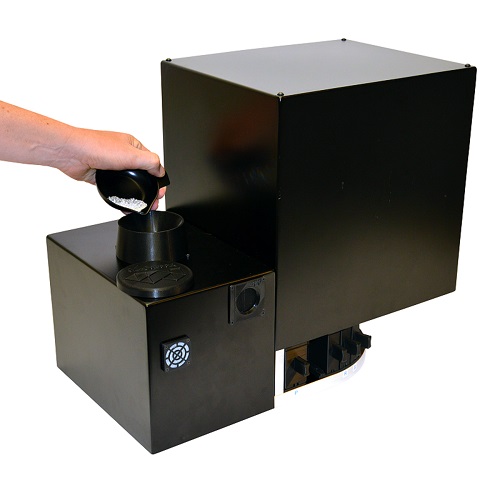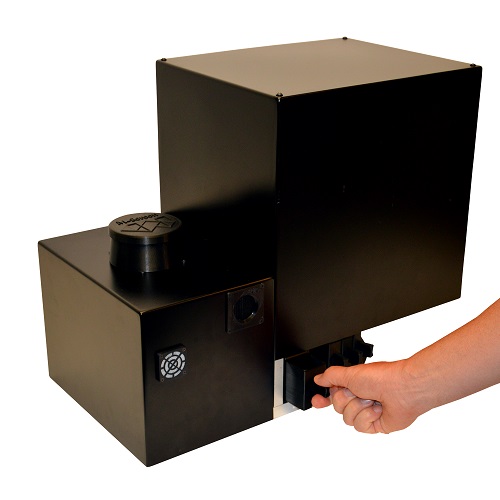The HRD Antwerp diamond lab is the largest diamond lab in the world issuing diamond certificates, grading and jewellery reports fully compliant with the rules for grading polished diamonds set by the International Diamond Council (IDC). Its primary shareholder is the Antwerp World Diamond Centre (AWDC), which represents the Belgian diamond industry since 1973. Having over 30 years of grading experience under its belt in Antwerp, the world’s oldest diamond hub, the lab is making continuous contribution to diamond market transparence and fair trade based on the rules established by the World Federation of Diamond Bourses (WFDB) and the International Diamond Manufacturers Association (IDMA). Peter Macken, HRD Antwerp’s CEO, describes the company’s business to Rough&Polished.
What are the latest news from HRD Antwerp you are proud of most of all?
 Without any hesitation the recent introduction of the M-Screen, a superfast automated melee screening device HRD Antwerp introduced for the first time on the September Hong Kong exhibition.
Without any hesitation the recent introduction of the M-Screen, a superfast automated melee screening device HRD Antwerp introduced for the first time on the September Hong Kong exhibition.
Why is this so important?
As the technology required to grow diamonds within a controlled lab environment has gradually matured and the overall manufacturing costs decreased, the production of gem quality lab grown diamonds has now become financially viable. With more and more companies venturing into the production of lab grown diamonds these days, an influx of such diamonds entering the market seems inevitable.
Due to the fact the quality of these diamonds produced today is of such a high quality, differentiating natural diamonds from their lab-grown counterparts has become increasingly more difficult. All HRD Antwerp labs have the expertise and state of the art equipment to screen and detect lab-grown diamonds but the financial cost of these examinations often outweighs the value of small melee size diamonds.

The development of the M-Screen, an automated melee screening device therefore deemed necessary. This superfast device screens round brilliant diamonds from 1 to 20 points for natural, potential lab-grown, potential HPHT colour enhanced diamonds and simulants at speeds several times higher than the nearest competitor.
It is of major importance that all natural, lab-grown, HPHT treated diamonds and simulants are identified in order to sustain trust throughout the diamond pipeline. The introduction of the M-Screen is of huge significance in regards maintaining consumer confidence. In addition to the commercialization of the M-Screen, HRD Antwerp will start offering a screening service in its diamond lab in Antwerp as of November 15, 2015.
What stones do you classify? What is the cost of classification services, what other services do you provide to customers? How much time does it take to classify a diamond?
Since its founding in 1976, the HRD Antwerp Diamond Lab has grown into one of the most respected grading labs in the world. We issue reliable diamond certificates, grading and jewellery reports fully compliant with the IDC rules, we are the only international lab that strictly adheres to these rules which have been approved by the World Federation of Diamond Bourses and the International Diamond Manufacturers Association, the industry’s two leading representative bodies. These rules provide a guarantee for transparency.
An HRD Antwerp Diamond Certificate confirms a diamond’s authenticity and describes its characteristics, the so-called 4C’s; Carat, Colour, Clarity and Cut.
Carat is the weight of a diamond. One carat is divided into 100 points and equals 0,2 g.
Colour. Most diamonds range in colour from colourless to slightly yellow. The best grade being colourless. A perfect diamond has no colour at all and the best grade is D- (Exceptional White +). Diamonds can also occur in various colour ranges called “fancy colours”.
Clarity refers to the purity of a diamond. As they are a product of nature, most gem quality diamonds have minor internal characteristics or inclusions. Size, number and location of the characteristics define the clarity grade when examined with a loupe 10x. The best quality is loupe clean (Internally Flawless or IF).
Cut. A diamond’s cut is essential to its beauty; the cut is divided into 3 grades: proportion-polish-symmetry. Each grade is evaluated according to 4 parameters – Excellent – Very Good -Good – Fair.
HRD Antwerp created a tamper-proof certificate. We incorporated exclusive security features that are only visible by loupe and/or UV light.
The price of an HRD Antwerp certificate or grading report largely depends on the size (weight) of the diamond. For more and detailed information on HRD Antwerp services including the price lists please visit our website www.hrdantwerp.com.
Do synthetic diamonds present a threat to the natural diamond market?
As consumer demand for diamonds is forecasted to grow in the years ahead, undisclosed synthetic diamonds entering the market does remain a challenge for traders and consumers alike. It therefore is very important that all lab-grown diamonds can be identified by a professional lab. It is the diamond industry’s responsibility to ensure the consumer is never misled. We at HRD Antwerp take this task to heart.
In 2005, HRD Antwerp introduced the D-Screen, the world’s most compact screening device for diamonds. We additionally developed the Alpha Diamond Analyzer, a unique diamond detection and type screening instrument and recently the M-Screen was launched in Hong Kong. All of these state-of-the-art instruments serve one single purpose, to offer the diamond industry the tools it needs to uphold a flawless reputation while enhancing consumer confidence.
What is the main role of diamond certificates?
For many end consumers, buying a diamond remains a significant purchase. As a customer you want the most accurate and independent diamond lab to objectively examine your diamonds. HRD Antwerp’s consistent, transparent and objective grading methodologies, in addition to being globally recognized as one of the most reputable authorities in diamond certification, all add to providing trust throughout the diamond pipeline.
Do you collaborate with other diamond laboratories?
All international diamond labs do meet on official occasions as it is important to maintain relationships in order of good industry governance. Over the years, HRD Antwerp has also collaborated with universities in regards advanced research programmes.
In which countries does HRD Antwerp maintain its offices?
HRD Antwerp has fully operational diamond labs in Antwerp, Mumbai and Istanbul. We also have a sealing service in Hong Kong and lab links worldwide. In addition, we have offices in Shanghai, Surat, Ramat Gan and Madrid.
What educational and training courses are provided by HRD Antwerp?
The HRD Antwerp education department combines over 40 years of experience with more than 550 years of diamond history. We offer international renowned courses on diamond grading, gemology, jewellery design, rough planning and sorting, diamonds polishing, pearls and more. For companies looking for specific training programmes, we offer tailor-made courses or workshops, both on location as well as in our education centres. The diplomas issued by HRD Antwerp are internationally recognized.
Antwerp is the diamond industry’s primary business centre and home to an impressive cluster of diamond professionals. Antwerp is also a lively cosmopolitan environment, so when you choose to study in Antwerp you will experience this unique atmosphere setting this city apart from all other diamond centres.

